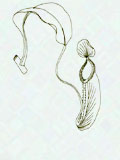

 |
 |
Flora
| Getting ahead by falling down: the strange case of Choerospondias axillaris | |
| Wind pollination in Hong Kong |
Getting ahead by falling down: the strange case of Choerospondias axillaris
by Richard T. Corlett
The Hog Plum, Choerospondias axillaris (Anacardiaceae), is a large, deciduous tree whose natural distribution in Hong Kong has been obscured by widespread planting. It has large (c. 30 mm x 25 mm x 25 mm), yellow, fleshy fruits, each with a single large (20 mm x 15 mm x 15 mm) and very woody stone. Uniquely in the Hong Kong flora, these fruits are dropped to the ground as soon as they are ripe. The fruit flesh is watery and has a high sucrose content, suggesting that it is targeted at mammals, rather than birds (Corlett, 1996; Ko et al., 1998). I have seen macaques eating Choerospondias, but it makes no sense to present fruits to an arboreal primate on the ground. We have also occasionally found the distinctive stones in civet scats, which makes a bit more sense, although civets climb well and obtain most of the other tree fruits they eat direct from the canopy. Neither civets nor macaques, however, explain the occurrence of small groups of cleaned stones deposited in forest patches on Ma On Shan and elsewhere, often with no Choerospondias tree in sight.
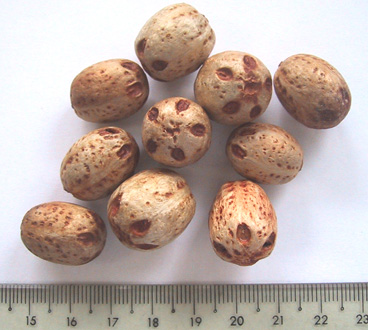 |
The name "Hog Plum" suggests pigs as possible dispersal agents, and this cannot be ruled out, but a more likely explanation is provided by a recent paper in Biotropica (Chen et al., 2001). Jin Chen and his colleagues at the Xishuangbanna Tropical Botanical Garden in Yunnan have shown that, in the Mengla National Nature Reserve, Choerospondias axillaris is dispersed by the Indian Muntjac, Muntiacus muntjak – the same muntjac (barking deer) as we have in Hong Kong. The fruits are apparently swallowed whole and then the seeds are regurgitated undamaged after several hours of rumination. The authors suggest that the relatively high protein and calcium content of the pulp may make these fruits an important part of the muntjac’s herbivorous diet. Chen et al. say that the muntjac is also an important dispersal agent for several other large-seeded woody plants in the same area. The only one of those mentioned that grows in Hong Kong is Phyllanthus emblica (Euphorbiaceae), which has spherical, pale green fruits around 18 mm in diameter, with a single hard stone.
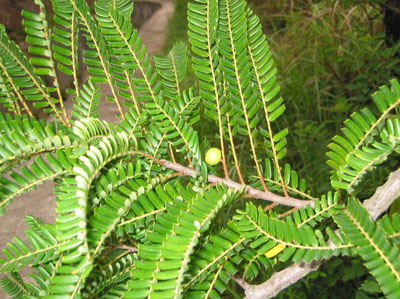 |
|
Phyllanthus emblica with fruit |
Bibliography
Chen, J., Deng, X.B., Bai, Z.L., Yang, Q., Chen, G.Q., Liu, Y. and Liu, Z.Q. (2002). Fruit characteristics and Muntiacus muntjac vaginalis (Muntjac) visits to individual plants of Choerospondias axillaris. Biotropica 33: 718-722.
Corlett, R.T. (1996). Characteristics of vertebrate-dispersed fruits in Hong Kong. Journal of Tropical Ecology 12: 819-833.
Ko, I.W.P., Corlett, R.T. and Xu, R.J. (1998). Sugar composition of wild fruits in Hong Kong, China. Journal of Tropical Ecology 14: 381-387.
 P.14-15
P.14-15
![]()
Wind pollination in Hong Kong
by Richard T. Corlett
The possibility that wind pollination is important in the tropics has been generally neglected. In the understorey of tropical evergreen rain forests, low wind speed, dense evergreen foliage and regular rainfall must all reduce the effectiveness of aerial pollen transport, and the low density and thus wide spacing of conspecifics in most plant species must strongly favour the directed movement of pollen by the animal vectors that are abundantly available year-round. However, the rain forest understorey is an extreme situation and open sites, seasonal rainfall and dominance by a single species, are all widespread in the tropics. Hong Kong is near the northern edge of the tropics and has many non-tropical taxa in its flora. How important is wind pollination here?
If a species is pollinated by wind, its pollen must be present in the air during the flowering season. Sampling of pollen suspended in the air, mostly in urban areas, and of the "pollen rain" preserved in surface samples, lake sediments and pollen traps, can give a general picture of aerial pollen transport. Although there are very few data from Hong Kong itself, several Hong Kong taxa are consistently represented in such samples from elsewhere in the region, including: the conifers, Amaranthaceae, Chenopodiaceae, Cyperaceae, Elaeocarpus, Engelhardtia, Euphorbiaceae (particularly Acalypha, Bischofia, Macaranga and Mallotus), Hamamelidaceae (Altingia), Ilex, Moraceae (Artocarpus, Broussonetia, Morus), Myrica, Myrsinaceae (mostly Myrsine), Myrtaceae (Syzygium and unidentified taxa), Palmae, Pandanus, Poaceae, Ulmaceae (Celtis, Trema) and Urticaceae (Boehmeria) (Corlett, unpublished review).
Pollen in the air comes not only from wind-pollinated plants, but also from some animal-pollinated taxa, particularly if they have open flower structures or "buzz-pollinated" flowers. In some cases, floral morphology, pollen characteristics and a tendency to gregariousness support the idea that the taxa listed above are wind-pollinated. Thus the conifers appear to be wind-pollinated even when they occur as subcanopy components of lowland rainforest. The grasses and sedges also seem to be consistently pollinated by wind, except, possibly, some rainforest understorey genera. Bees collect pollen from several species of Quercus (including Cyclobalanopsis) in Hong Kong, but the pendulous male inflorescences, which release clouds of pollen when touched, support the widespread assumption that this genus is wind-pollinated. At the other extreme, both floral morphology and visits by potential pollinators make it very unlikely that wind pollination is significant for Elaeocarpus or Ilex.
Between these extremes are many species with small, often inconspicuous, flowers, for which the relative importance of wind and insects in pollination is unclear. Corlett (2001) considered that the common dioecious tree, Myrsine seguinii, was pollinated by Apis cerana in Hong Kong, although bee visits were overwhelmingly to male plants, while Yumoto (1987) reported that flies were the major flower visitors on Yakushima Island. However, Kato (2000) considered the same species to be wind pollinated in the Amami Islands. Flowering male plants of this species release clouds of pollen when shaken, so I now think Kato is probably right and that the few bee visits I have observed to female plants are accidental.
A similar situation occurs with the pioneer trees Aporosa chinensis and Mallotus paniculatus (both Euphorbiaceae) in Hong Kong, with only the male plants visited by pollen-collecting bees, suggesting that pollen transfer must be by wind (Corlett, 2001). However, species of the same genera in the rainforest understorey in Sarawak appear to be pollinated by insects (Momose et al., 1998), as does Mallotus albus in southern India (Krishnan & Davidar, 1993). Staying with the euphorbs, I have never seen insect visitors to Macaranga flowers in Hong Kong and have always assumed that the whole genus was pollinated by wind. Recently, however, Moog et al. (2002) have shown that several Macaranga species are pollinated by thrips in the Malaysian rainforest. Thrips are tiny and easily overlooked, so the Hong Kong species need further study.
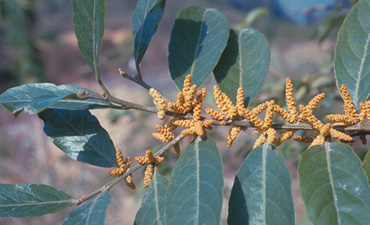 |
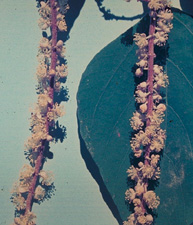 |
Spontaneous, ballistic release of pollen into the air, by stamens held under tension until anthesis, occurs in the Urticaceae and in one tribe of the closely related Moraceae, which includes the Hong Kong genera Morus, Broussonetia and Maclura. Although bees occasionally visit the flowers of many of these species, the automatic release of clouds of tiny pollen grains makes most sense as an aid to wind pollination. Both floral morphology and the aerial pollen count also suggest that at least some tropical members of the related family Ulmaceae may be wind-pollinated. This has been proposed for Gironniera spp. in Sarawak (Momose et al., 1998), although the same authors considered that bees pollinated Trema tomentosa. In Hong Kong, Celtis sinensis flowers while leafless and releases pollen when touched, but it is also visited by bees that sometimes contact both anthers and stigmas.
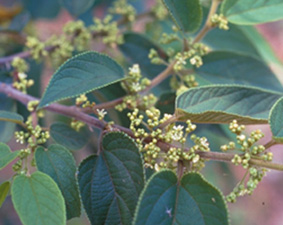 |
Coastal habitats, with their strong air movements, relative openness and tendency to single-species dominance, would be expected to favour wind-pollination more than inland areas. In fact, even here, most species have animal vectors, but Cox (1990) considered that the coastal pandan, Pandanus tectorius, was wind-pollinated, with the staminate inflorescences producing copious amounts of loose, dry pollen and the pistillate inflorescences acting as highly efficient pollen receivers. Kato (2000), however, considered that beetles (mostly Nitidulidae) were the main pollinators in the Amami Islands.
The degree of ignorance and uncertainty surrounding this apparently straightforward issue may be surprising, but the relative importance of wind and insects as pollinators is still debated for many well-studied temperate zone taxa. Proving pollination by wind is a lot more difficult than one might think. The traditional test has been to exclude insects with a mesh bag, but a mesh fine enough to keep out thrips and other very small insects will also greatly reduce air movements. A combination of mesh bags and insecticide might be worth trying. There is a future PhD in this for someone!
Bibliography
Corlett, R.T. (2001). Pollination in a degraded tropical Landscape: a Hong Kong case study. Journal of Tropical Ecology 17: 155-161.
Cox, P.A. (1990). Pollination and the evolution of breeding systems in Pandanaceae. Annals of the Missouri Botanical Garden 77: 816-840.
Kato, M. (2000). Anthophilous insect community and plant-pollinator interactions on Amami Islands in the Ryukyu Archipelago, Japan. Contributions from the Biological Laboratory Kyoto University 29: 157-252.
Krishnan, R.M. and Davidar, P. (1993). Nectar secretion and pollinator visitation patterns in Mallotus albus. In Pollination in the tropics (eds. G.K. Veeresh, R.U. Shaankar and K.N. Ganeshaiah), International Union for the Study of Social Insects, Bangalore, pp. 157-158.
Momose, K., Yumoto, T., Nagamitsu, T., Kato, M., Nagamasu, H., Sakai, S., Harrison, R.D., Itioka, T., Hamid, A.A. and Inoue, T. (1998). Pollination biology in a lowland dipterocarp forest in Sarawak, Malaysia. I. Characteristics of the plant-pollinator community in a lowland dipterocarp forest. American Journal of Botany 85: 1477-1501.
Moog, U., Fiala, B., Federle, W. and Maschwitz, U. (2002). Thrips pollination of the dioecious ant plant Macaranga hullettii (Euphorbiaceae) in Southeast Asia. American Journal of Botany 89: 50-59.
Yumoto, T. (1987). Pollination systems in a warm temperate evergreen broad-leaved forest on Yaku Island. Ecological Research 2: 133-145.
 P.15-16
P.15-16
|
Porcupine! |
 Copyright © 2000 |